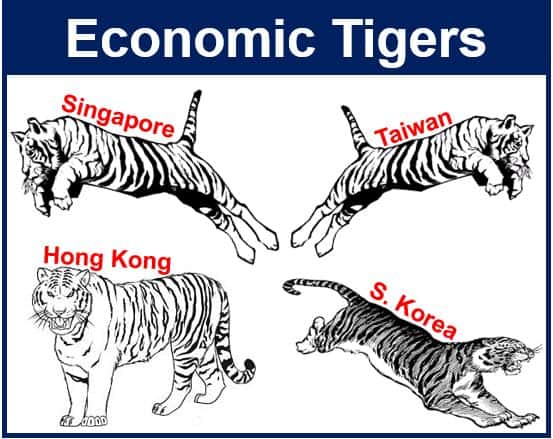What are the Economic Tigers? Definition and meaning
The term Economic Tigers, also known as the Asian Tigers or Asian Dragons, refers to Taiwan, South Korea, Singapore and Hong Kong. These four nations transformed from low-income to advanced economies (rich countries) from the 1960s to 1990s.
These four countries maintained GDP (gross domestic product) growth rates in excess of 7% annually over that thirty-year period.
By the beginning of this millennium, the Economic Tigers had become advanced and high-income nations, specializing in areas of competitive advantage.
 The Economic Tigers were virtually the only non-oil states to turn from low-income into advanced economies from 1960 to 1990.
The Economic Tigers were virtually the only non-oil states to turn from low-income into advanced economies from 1960 to 1990.
While Singapore and Hong Kong became world-class international financial hubs, Taiwan and South Korea turned into world-leading manufacturers of information technology.
Many economists in emerging countries today study these countries’ success stories closely, using them as role models for their nations’ economic policies.
When the United Nations sent Dutch economist Dr. Albert Winsemius to Singapore to salvage the struggling island economy, he gloomily described it as “this poor little market in a dark corner of Asia.” Just over half a century later, more than 1 in every 6 households in Singapore have $1 million in cash savings.
Some newspapers today have started to include other Asian nations with rapid economic expansion, such as China, in the list of Economic Tigers.
Not a ‘totally’ free-market during development
Many promoters of totally-free markets quote the Economic Tigers as successful examples – with their low taxes, minimal welfare states and export-led regimes.
Some of their success, though, did involve state intervention. In all cases there was state-imposed below-market interest rates for loans to certain exporting companies.
The state spent much more money on education compared to other developing nations at the time.
However, there was definitely less overall government spending as a proportion of GDP, and more free trade, compared to other emerging and low-income economies during the second-half of the 20th century.
The Economic Tigers’ market-oriented economic policies helped sustain spectacular economic growth rates for several decades.
During the early years of economic growth, these countries’ political systems were relatively non-democratic and authoritarian. There were high levels of US bond holdings, and public and private savings rates were well above those seen in other nations.
Economies today which are expanding rapidly and whose citizens’ standard of living is rising are sometimes referred to as ‘tiger economies’. Ireland became known as the ‘Celtic Tiger’ after its rapid GDP growth from 1995 to 2000. Dubai in the 1990s became the ‘Gulf Tiger’.
The Philippines, Thailand, Malaysia and Indonesia are known as the ‘Tiger Cub Economies’.
North & South Korea – Success and Failure
The difference between the economies of North and South Korea is enormous. One is an example of half a century of economic achievements, while the other is the complete opposite.
Below are some data showing how different the two countries are today:
GDP: North – $15,400,000,000. South – $1,435,000,000,000 trillion.
GDP Per Capita: North – $1,800. South – $36,601.
Total Exports: North – $4.71 billion. South – $552.6 billion.
Infant deaths per 1,000 live births: North – 26.21. South – 4.08.
Life Expectancy: North – 69.2. South – 79.3.
Access to Internet: North – 0.1%. South – 81.5%.
According to the BBC, North Koreans are three inches shorter than South Koreans. Experts attribute this to better quality nutrition in South Korea during a child’s first years.
Video – South Korea’s economic success
This documentary by The Korea Foundation shows how South Korea, once literally the poorest country in the world, escaped abject poverty and grew to become the 14th largest economy in the world. The video identifies key factors behind the country’s economic success.
General Douglas MacArthur once said of South Korea “This country has no future. It will not be restored even in a 100 years.”

